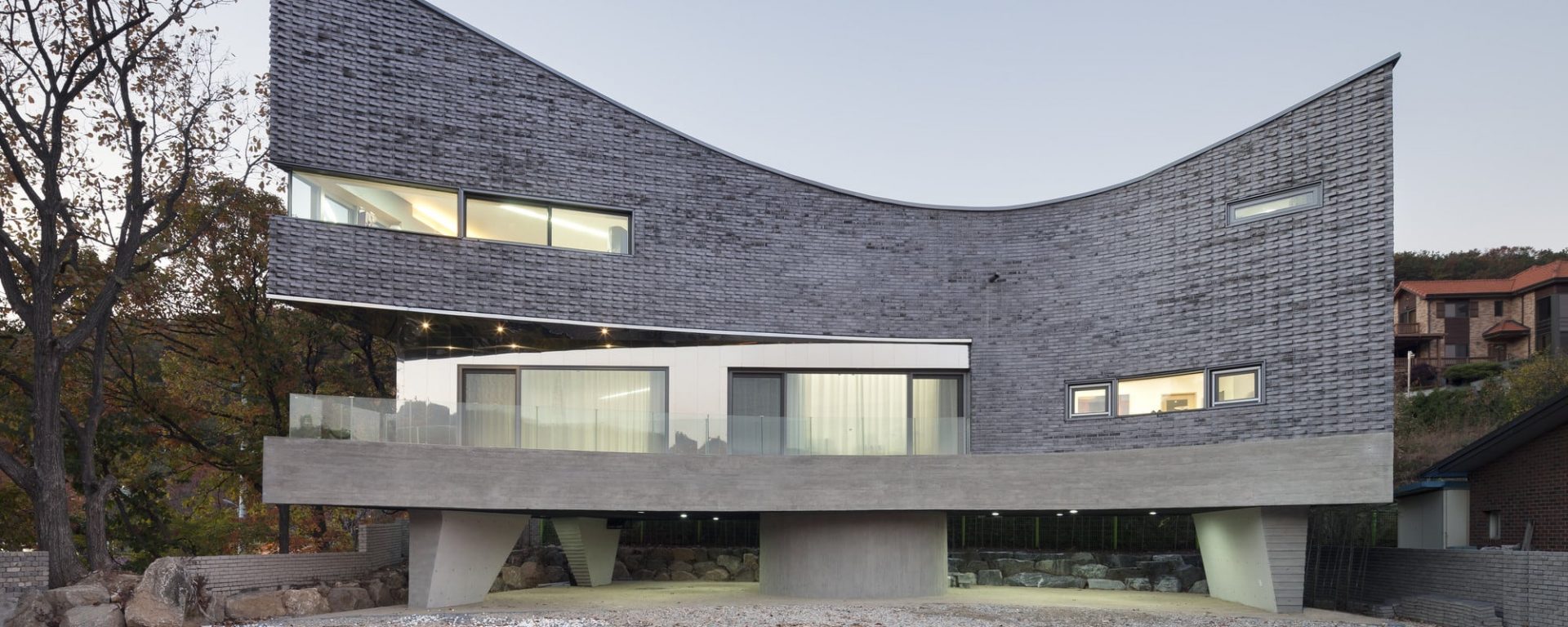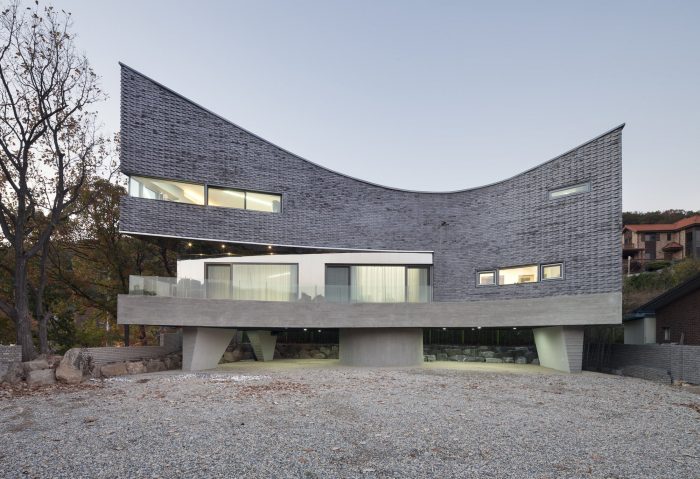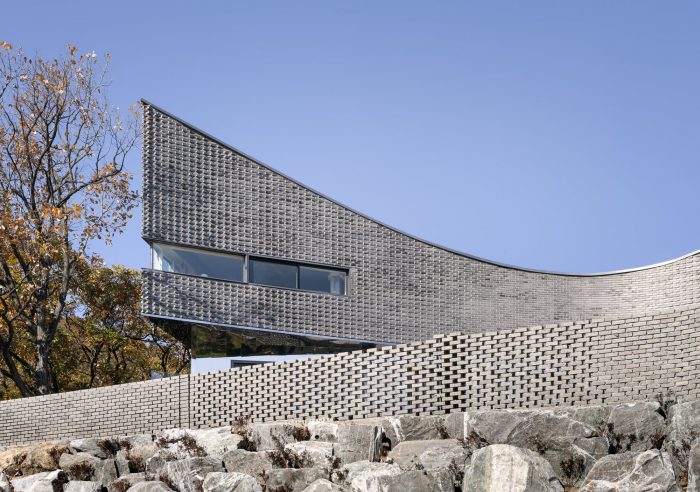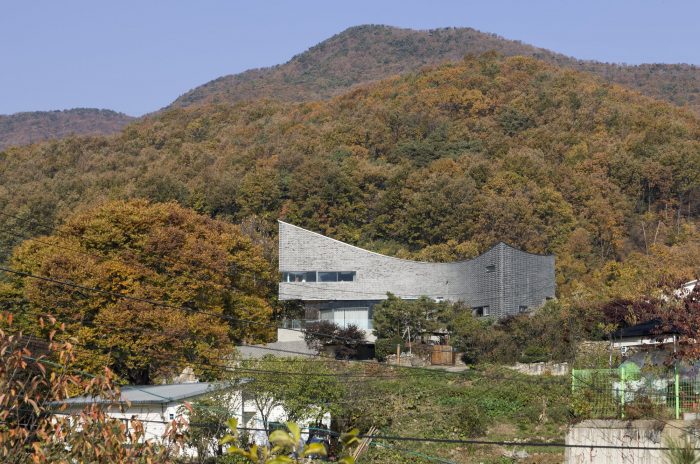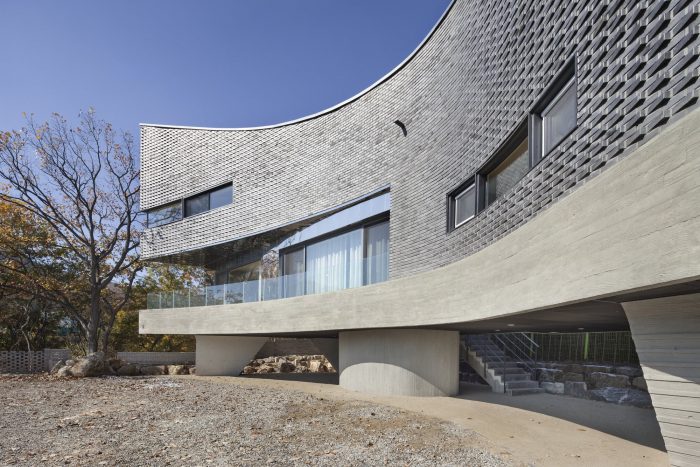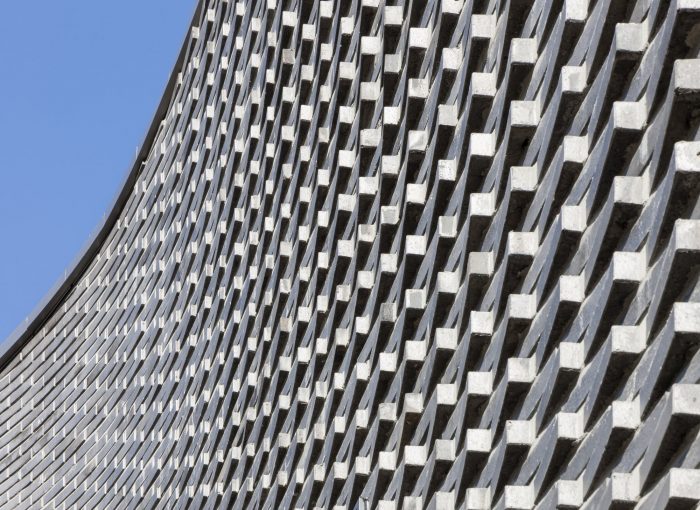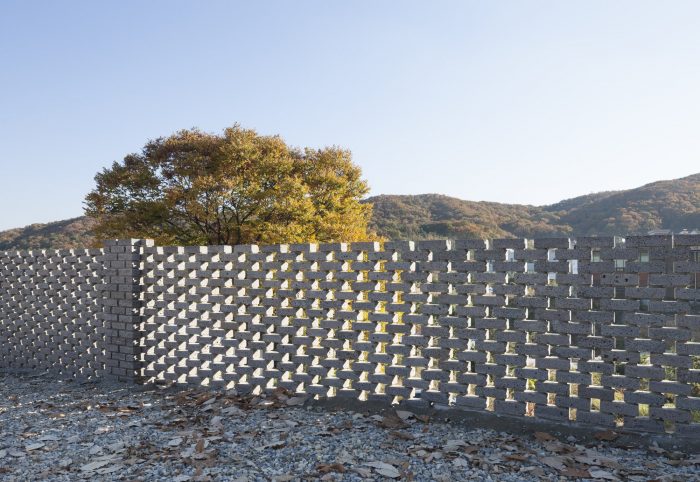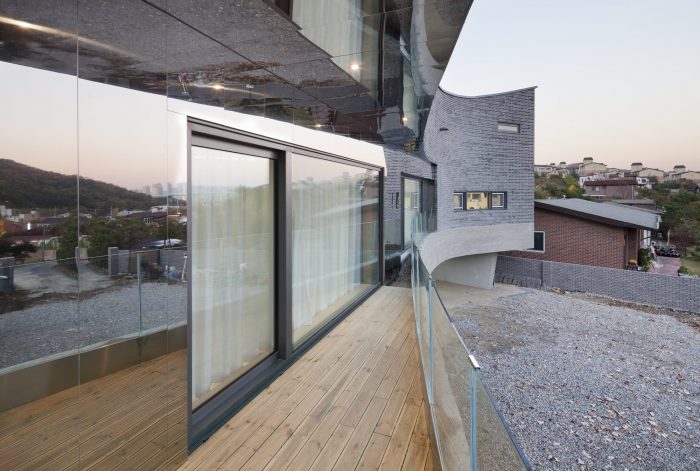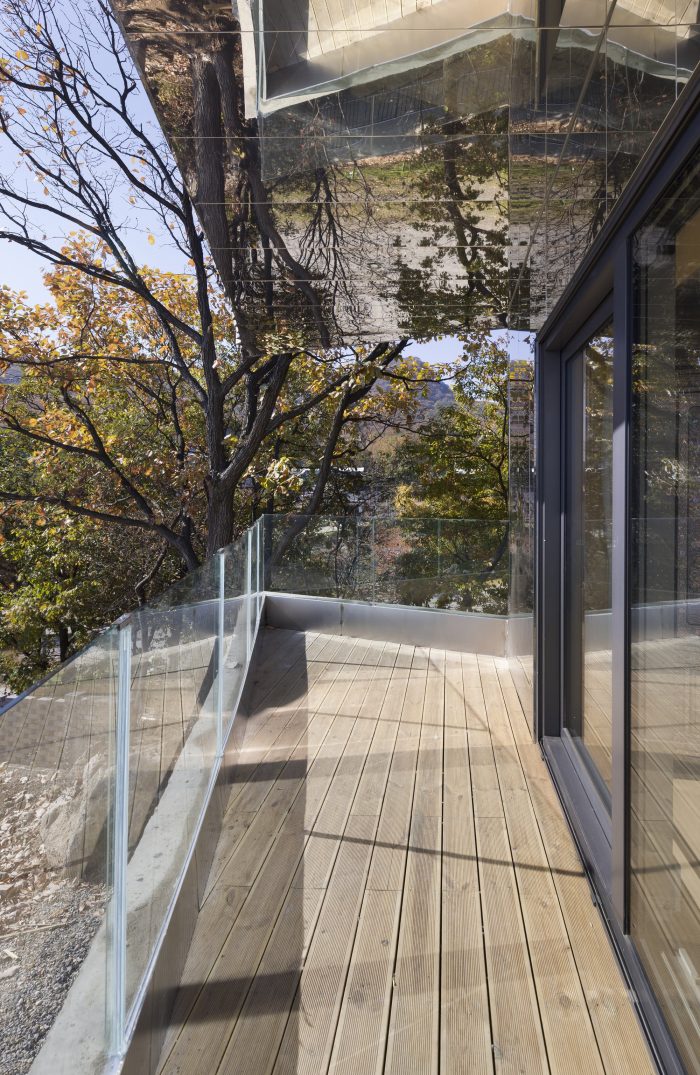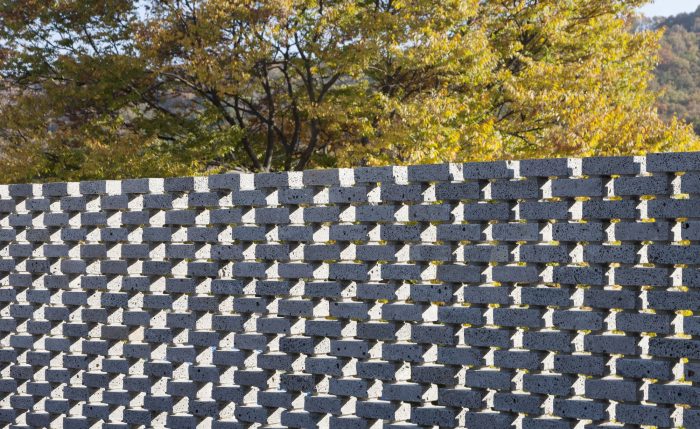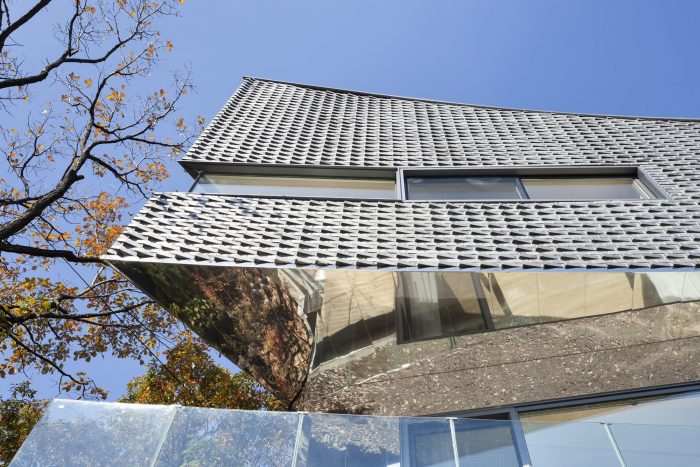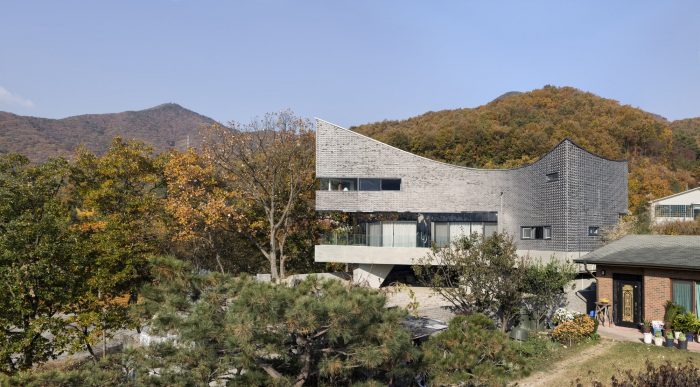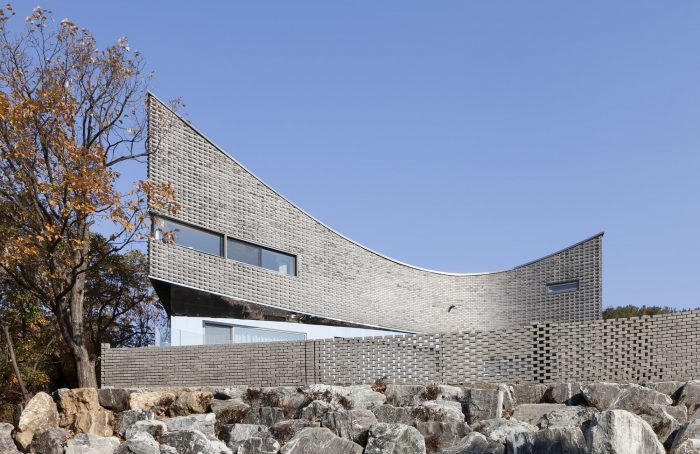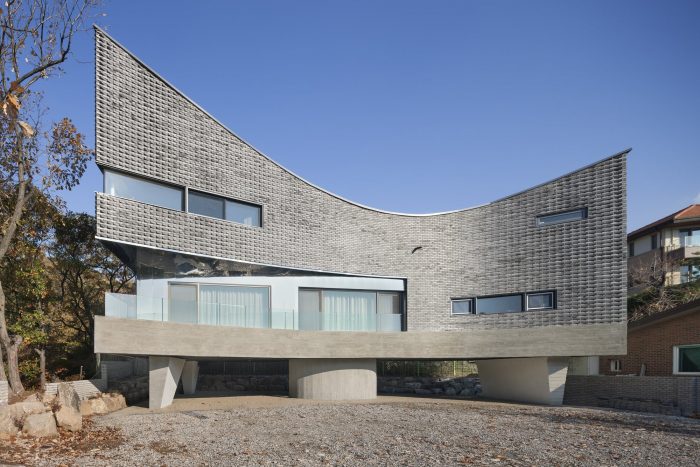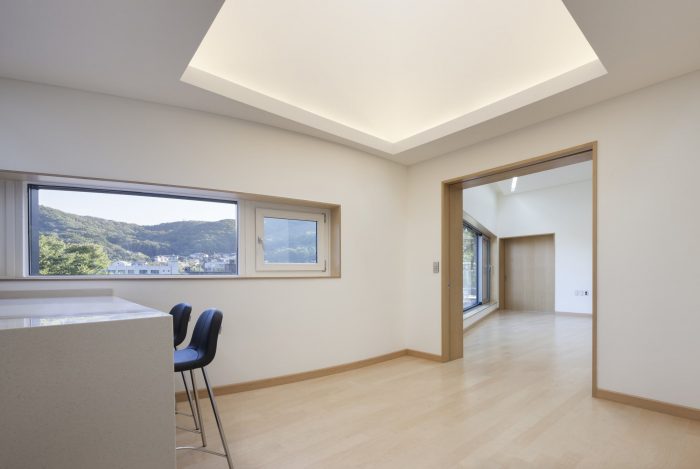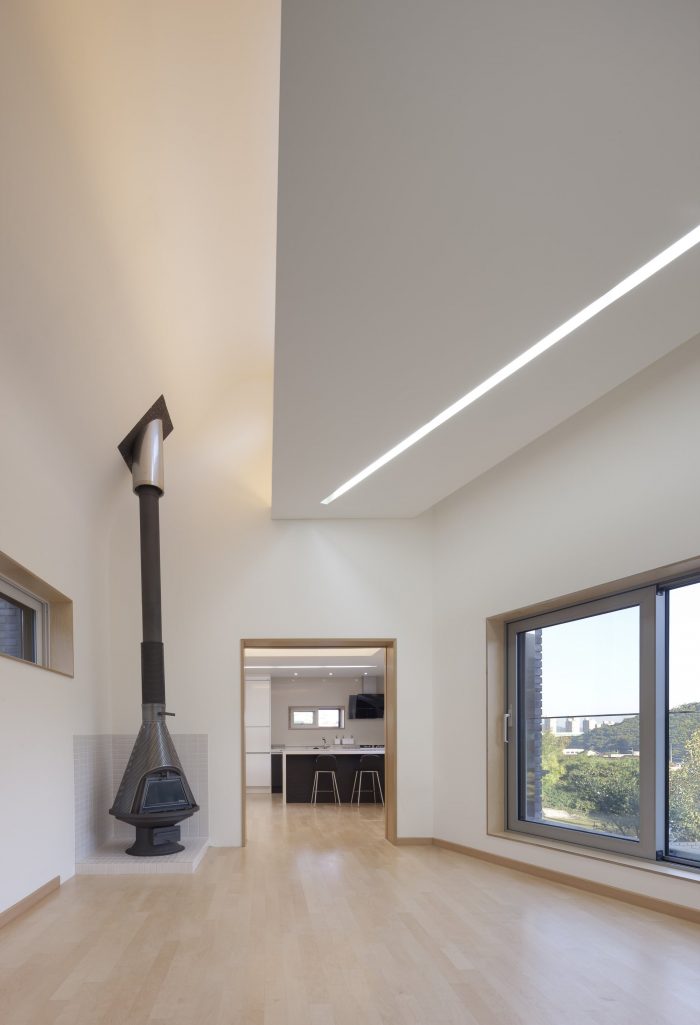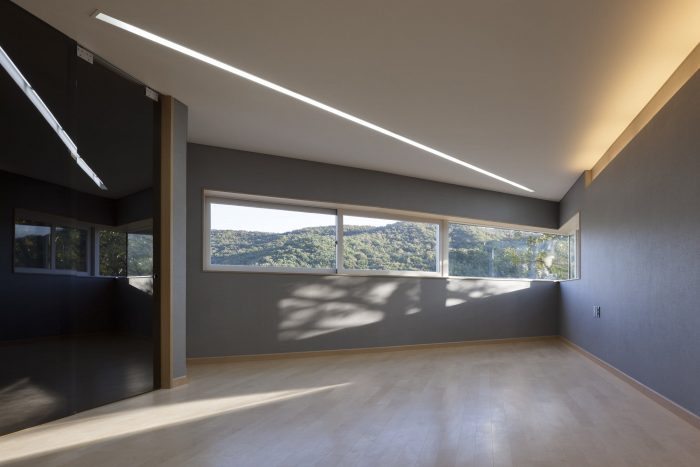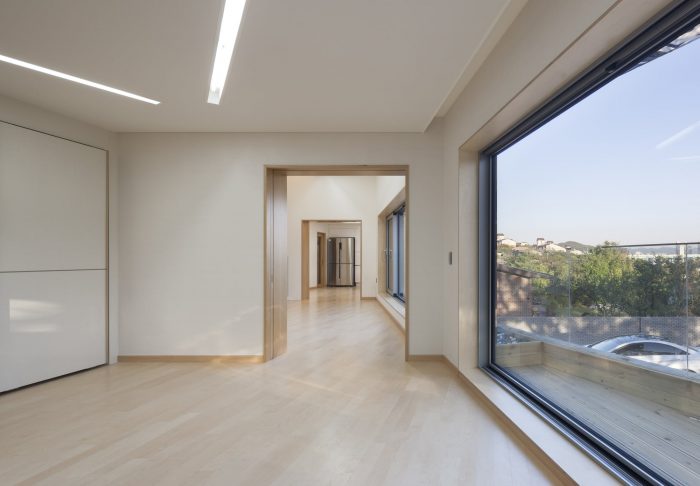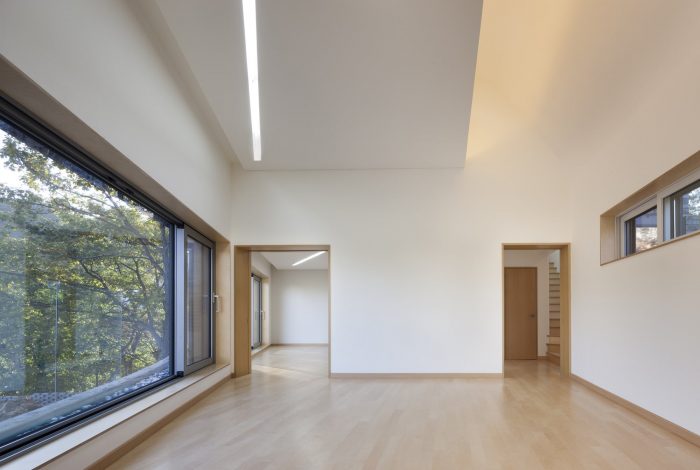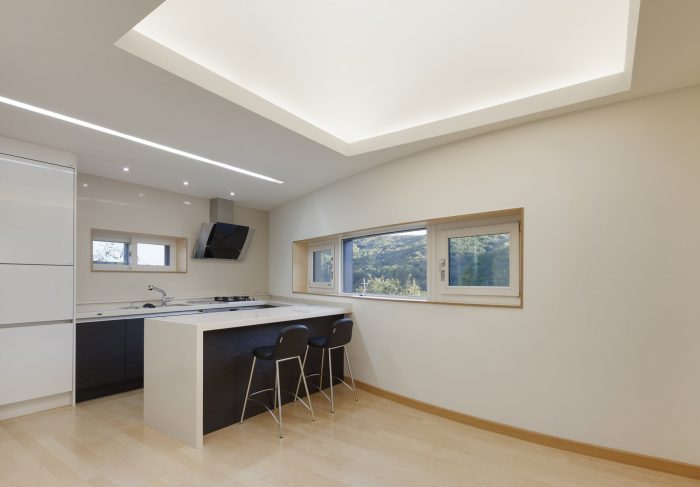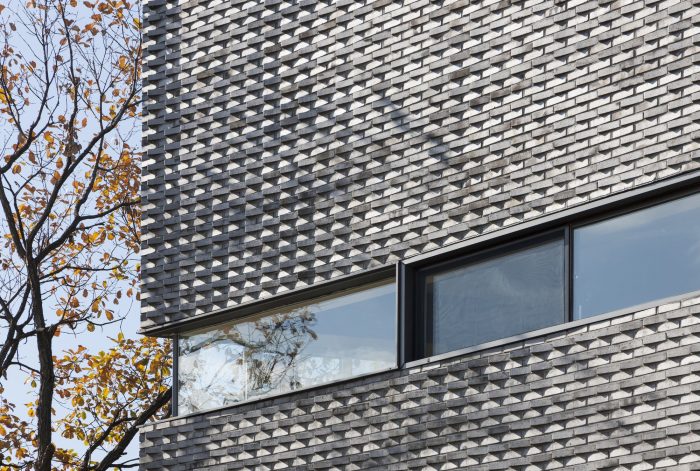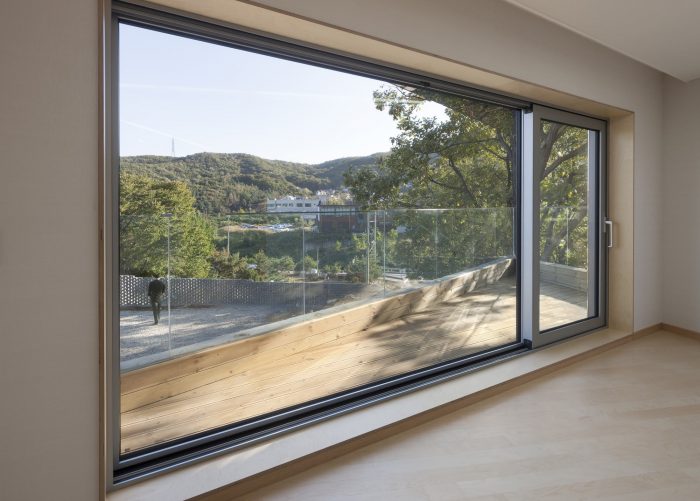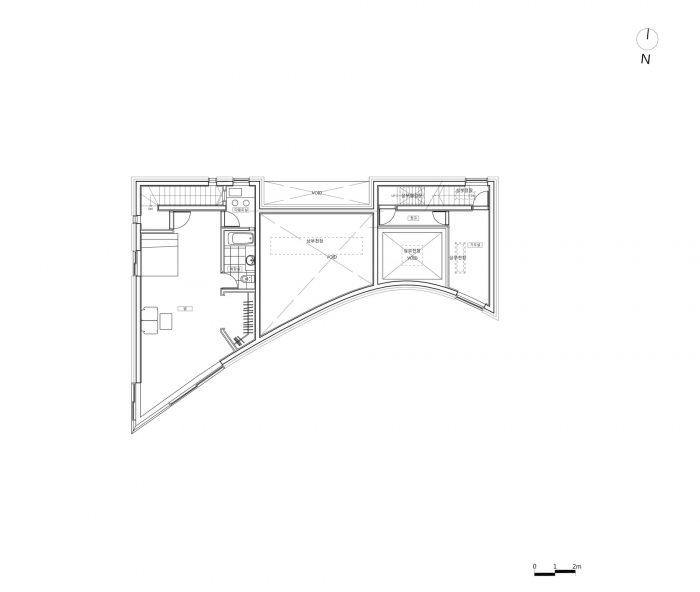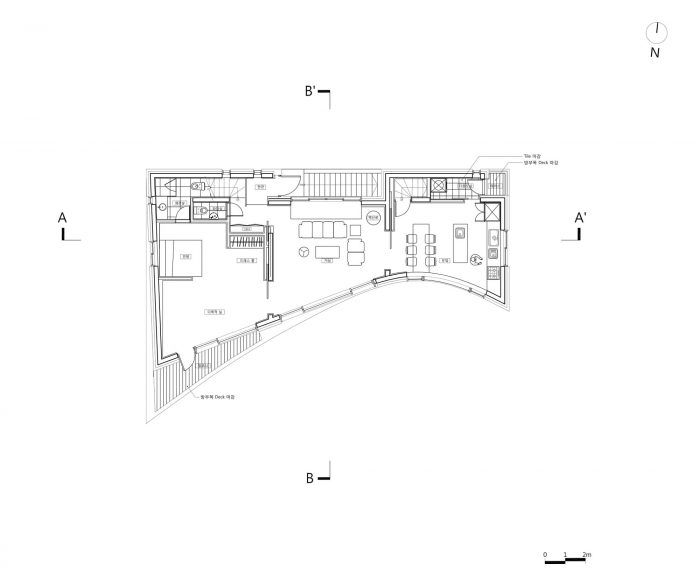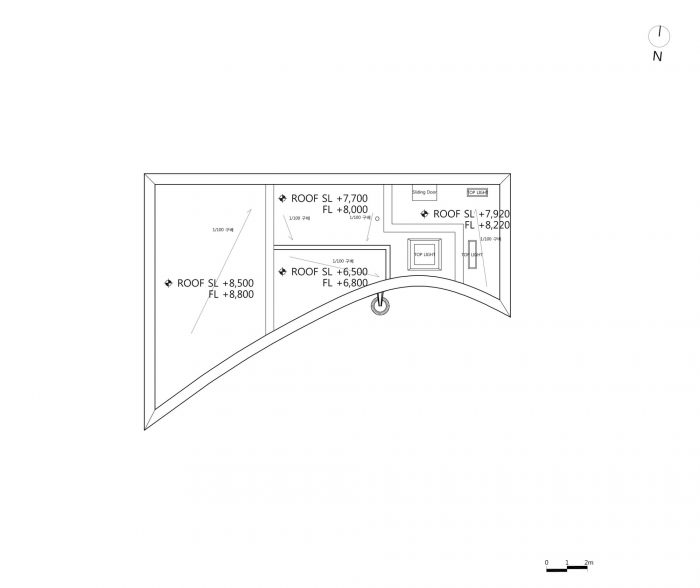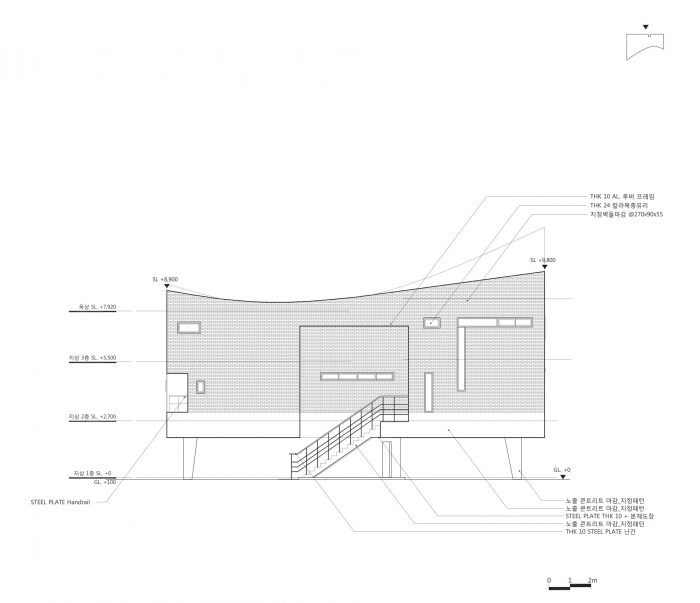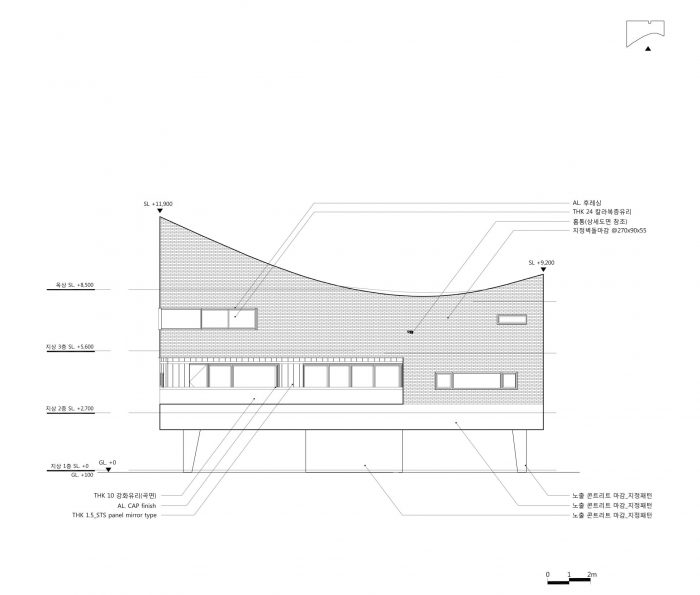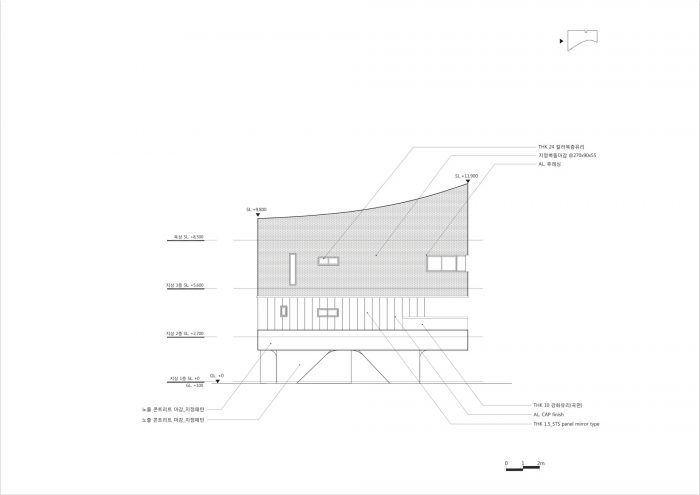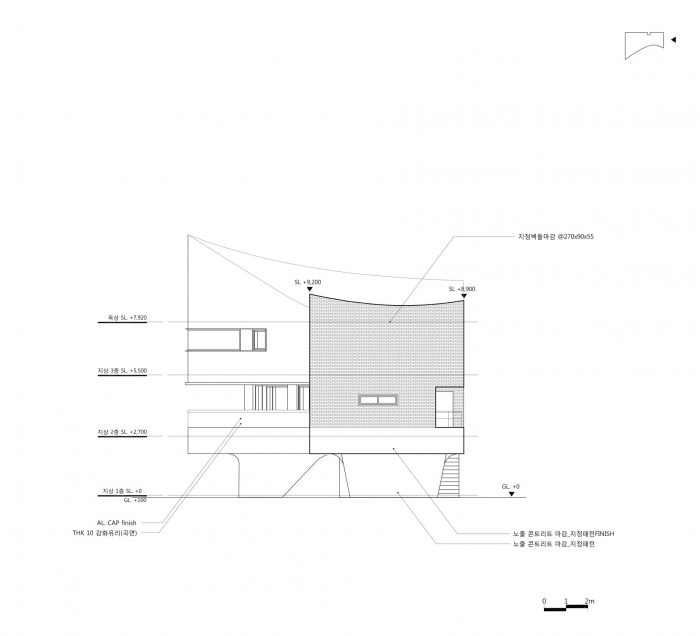没有停车场的家
我记得,我第一次去看这个地方时,是下雪后的一个冬日。那是一块难得的住宅地,在光雾山下的小路的死角处,向南有开阔的视野。这块地的独特之处在于,在停放了两辆以上的汽车后,很难将车转到小路上来,因为这是一条宽度只有4米的小路。 具有讽刺意味的是,根本的挑战不仅是解决停车问题,而且还要创造一个停车和园艺共存的空间。这与业主的生活方式密切相关,要决定是创造一个可以从客厅直接进入的花园,还是强调一个视觉花园。为了解决这个问题,整体形状是用更多的曲线来包裹这块地,并使用引力板从地面抬起约2米,以提高停车效率。 类似于凹透镜的体块形状是由停车需求和该地段的地形条件创造的。
There is no home for parking
I remember that it was a winter day after snowing when I first visited the site. It was a rare residential lot with an open view to the south at the dead end of a small path beneath Mt. Gwanggyo. What was unique about this lot was that it was very hard to turn the car to come out of the path after more than 2 cars parked, because it was a small path only 4 m in width. Ironically, the fundamental challenge was not only solving the parking problem but also creating a space for both parking and gardening to coexist. It was closely related to the lifestyle of home owner to decide whether to create a garden directly accessible from the living room or to emphasize a visual garden. To resolve this issue, the overall shape was formed to encase the lot with more curves and lifted about 2 m from the ground using pilotis for more efficient parking. The shape of the mass resembling a concave lens was created by the parking needs and the topographical condition of the lot.
线条穿透天空
群山穿透天空,天空包含了作为自然的群山。在这里,山形成了线,而线则让人记住了土地上的山。光雾山的地形在地块上方低空流动,地块显示了整个景观,仿佛是对优雅的流动的回应。在这个地方,土地是空间的证明,是关于物质的一切。这里创造的形状包含了作为陶罐的天空,显示了土地作为空间物质的潜力。它画了一个形状,但创造了一个空间,把天空显示在形状之外,把自己隐藏在自然中。线条应该隐藏在自然中,还是自然应该显示在隐藏的线条中?这是这片土地的基本挑战,也是对背景的真诚回应。这直接关系到韩国传统空间中的地形应该如何解释。韩国传统空间追求的是不完全隐藏在自然中,但又与周围的自然环境相协调的形状。它是基于后二元论的和谐之美,在隐藏在自然中的同时证明了自己的存在,而不是以其形状和线条支配自然。
The line penetrates the sky
The mountains penetrate the sky and the sky contains the mountains as nature. Here, the mountains form lines and the lines remember the mountains in the land. The terrains of Mt. Gwanggyo flow low above the lot and the lot displays the entire view as if it responds to the graceful flow. At this site, the land is the proof of space and everything about the substance. The shape created here contains the sky as an earthenware jar and displays the potentiality of land as a spatial substance. It draws a shape, but creates a space that shows the sky outside the shape to hide itself in nature. Should the line be hidden in nature or should the nature be displayed in the hidden line? This was the essential challenge of this land and the sincere response to the background. This is directly related to how the topographies should be interpreted in Korean traditional spaces. Korean traditional spaces have pursued the shape that is not completely hidden in nature yet beautifully harmonized with surrounding nature. It is based on the post-dualistic beauty of harmony that proves its existence while hiding in nature rather than dominating nature with its shape and lines.
银色刻度中包含的光的流动
灰白色的砖块(传统砖)像鱼鳞一样拥抱着混凝土表面,同时稍微改变了角度。这个项目使用的传统砖块表面有银色的防水涂层,显示出与它们顶部和底部的粗糙表面不同的感性。具有两种不同表面的砖块被堆积起来,从1°到25°的角度形成一定的图案。换句话说,角度的变化是朝南的凹透镜形状的外皮如何定义其存在的另一种方式。砖墙的阴影随着太阳的移动将线条的流动转化为外皮的微妙变化。砖块表面的变化是为了根据入境者的视角和从山上观看图像的视角,以不同的方式阅读整个建筑。
The flow of light contained in silver scale
The ash-colored bricks (traditional bricks) embrace the concrete surface as fish scale while slightly altering the angles. The traditional bricks used for this project have silver water-repellent coating on the surface and show sentimentality different from the rough surfaces of their tops and bottoms. The bricks with two different surfaces were piled to form a certain pattern from angles 1° through 25°. In other words, the variation of angle is another way how the outer skin in the shape of a concave lens facing south defines its existence. The shadow of the brick wall caste as the Sun moves converts the flow of lines into the subtle change of the outer skin. The variation of the brick surface is intended to read the entire mass differently according to the perspective of incomer and the perspective of viewing the images from the mountains.
纹理的对比与和谐
传统砖块的粗糙纹理与高反射不锈钢的特性相结合,以不同的方式诠释了该地段。反映在不锈钢表面的天空和自然,扭曲了真正的物质是什么,打破了形状和纹理之间的界限。与陶瓷砖的粗糙质地不同,正面和侧面使用的不锈钢反射周围的风景,使自己消失。如果说砖块通过光影的变化来显示自己,那么不锈钢则通过使自己在自然界中消失而使自己去物质化。这种对比鲜明的质地具有不同的属性,在一个整体中相互对抗,但它们最终通过光的熄灭和反射建立平衡。
Contrast and harmony of texture
The rough texture of the traditional bricks interprets the lot in a different way in combination with the property of highly reflective stainless steel. The skies and nature reflected on the stainless steel surface distort what the true substance is to break the boundaries between shapes and texture. Unlike the rough texture of ceramic bricks, the stainless steel used on the front and on the side reflects the surrounding landscapes to make itself disappear. If the bricks reveal themselves by the change of light and shadow, the stainless steel de-materializes itself by making itself disappear in nature. Such contrasting textures have different properties and confront each other in a single mass, but they ultimately establish balance through the extinction and reflection of light.
作为自然之流的空间
用于停车的导流板自然地成为空气流通的开口。夏天的微风从山脊上吹下来,使建筑周围的空气循环,从而减少热负荷。同时,每个房间都有窗户用于交叉通风,并被规划为允许空气自然循环。客厅顶部的电动窗在夏天可以释放出加热的空气,以实现由温差引发的空气循环,这被称为堆积效应。北面的楼梯被规划为空气的缓冲区,以抵御冬季冰冷的西北风,尽量减少热量损失。朝南的前窗在冬季有足够的阳光,可以利用自然阳光实现能源效率的最大化。特别是,天花板也是多样化的,以邀请尽可能多的自然光进入建筑,自然控制照度。
Space as a flow of nature
The pilotis for parking naturally serves as an opening for air ventilation. The summer breeze coming down from the mountain ridge circulates the air around the building thus reducing the heat load. Also, each room has windows for cross-ventilation and is planned to allow natural circulation of air. The motorized window on top of the living room can release heated air in summer for air circulation triggered by the difference in temperature known as stack effect. The staircase to the north is planned to serve as a buffer of air against the freezing northwestern winds in winter to minimize heat loss. The front windows facing the south allow sufficient sunlight in winter to maximize energy efficiency with natural sunlight. In particular, the ceiling is also diversified to invite as much natural light as possible into the building to control illumination naturally.
对传统空间的新技术诠释
空间的流动借鉴了韩国传统住宅中处理空气流动的方法。详细来说,底部的引流板扩大了暴露在外部空气中的体积表面,以减少热能的负荷,并在夏季实现自然通风。这类似于韩国传统空间中的开放式客厅的原则。这意味着整个建筑允许通风以保持建筑的凉爽。另一方面,在冬季,混凝土地板被尽可能地做成厚实的热质,类似于韩国传统建筑中的Ondol地板,以达到最大的隔热效果,阻挡来自地下的冷空气。同时,二楼的内部空间有一个开放的客厅、卧室和厨房,可以根据不同的需要用推拉门灵活地分割和组合。这是对韩国传统住宅可变空间的现代重新诠释,既可以作为一个大房间,也可以作为较小的独立房间使用。
New technical interpretation of traditional space
The flow of space was borrowed from the method of handling the flow of air in traditional Korean homes. In detail, the pilotis on the bottom expands the surface of volume exposed to outer air to reduce the load of heat energy and allows natural ventilation in summer. This is similar to the principle of open living rooms in Korean traditional spaces. It means that the entire building allows ventilation to keep the building cool. In winter, on the other hand, the concrete floor is made as thick as possible as a thermal mass, similar to Ondol floors of Korean traditional architecture for maximum insulation, to block the cold air from the underground. Also, the interior space of the second floor has an open living room, bedroom, and kitchen which can be divided and combined flexibly with sliding doors for different needs. This is a modern reinterpretation of the variable space of Korean traditional homes that can be used either as a big room or as smaller individual rooms.
Architects: JOHO Architecture
Area : 40 m²
Year : 2012
Photographs :Namgoong Sun
Country:SOUTH KOREA

